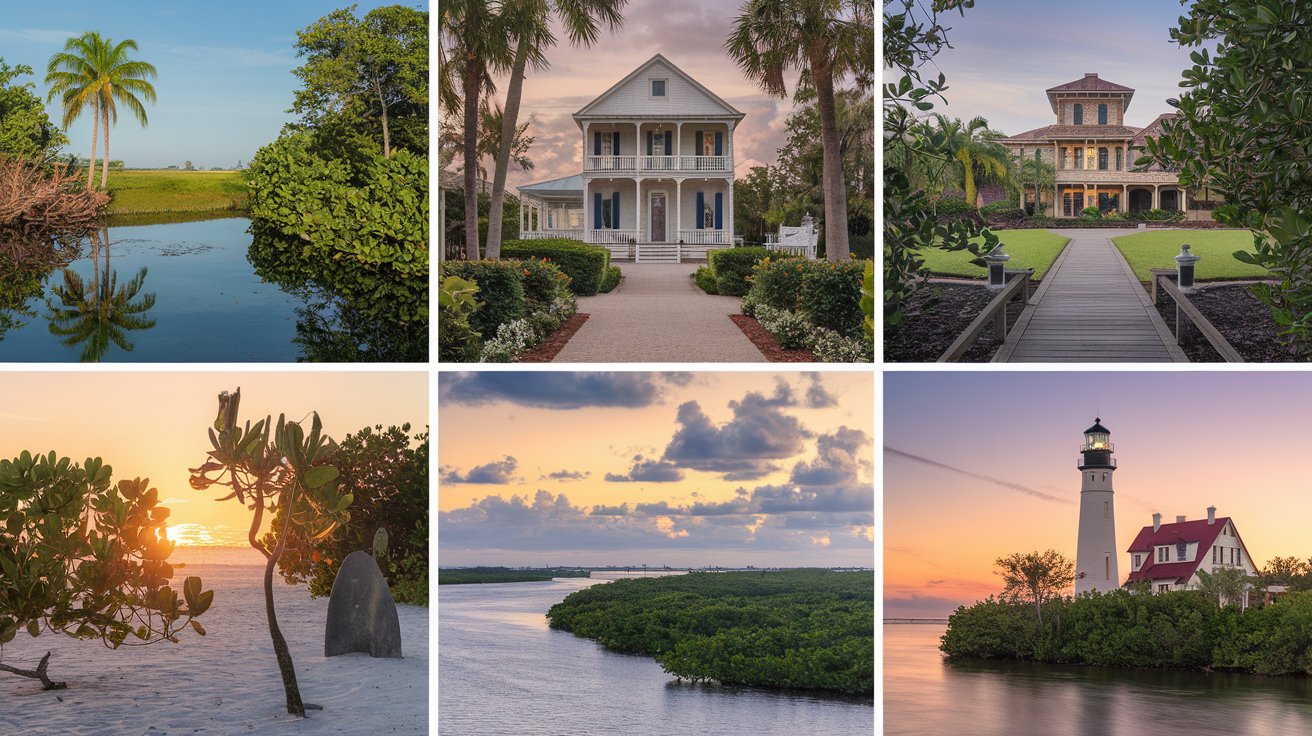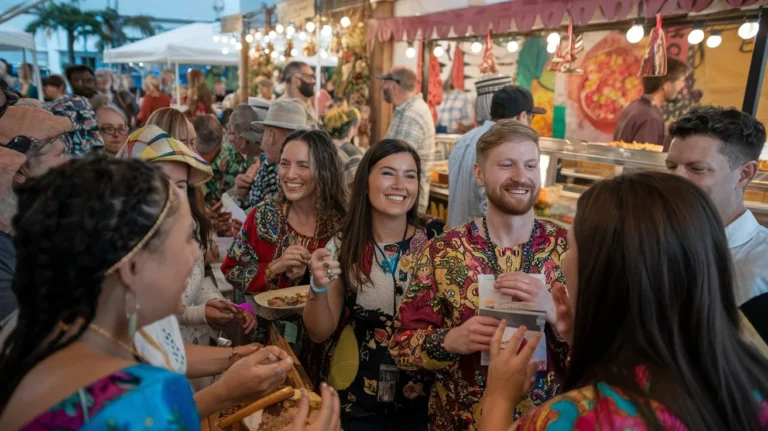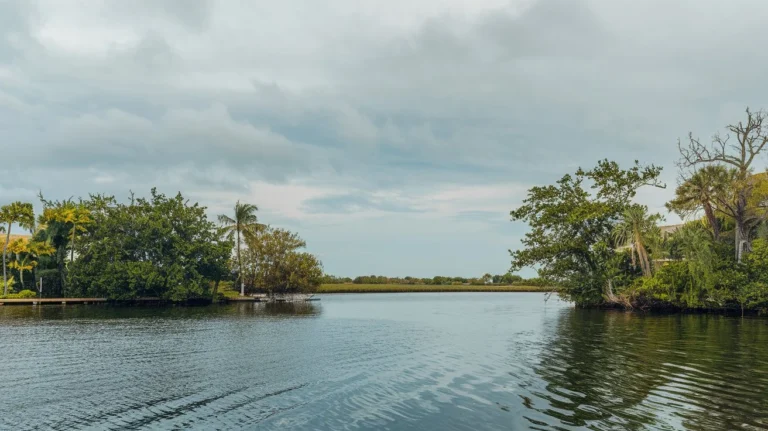Fort Myers has beaches, yes, but so much more. Beyond the beach lies a treasure trove of historical sites that bring the area’s past to life from indigenous civilizations and inventors to utopian communities and old homes. These places allow you to time travel while enjoying the laid back Southwest Florida. Whether you’re a history nerd or just looking to add some educational fun to your beach vacation the historic sites near Fort Myers are worth visiting.
1. Edison and Ford Winter Estates
The Edison and Ford Winter Estates are two of Fort Myers’ most famous historical sites. Once winter homes for inventor Thomas Edison and automobile pioneer Henry Ford the estates are now a museum and botanical garden open to the public.
History of the Estates
Thomas Edison bought the property in 1885 and built his winter home “Seminole Lodge” where he spent more than half his life. Henry Ford, Edison’s friend, bought the adjacent property in 1916. The estates showcase the innovation and creativity that defined these two men’s lives.
What to See and Do
Explore Edison’s laboratory, the main museum and the botanical gardens with over 1,000 plants from around the world. The estate also has Edison’s original home, Ford’s home and exhibits of their inventions and achievements. A walk through the estates is like stepping into a time machine and into American history.
Visitor Information
Open year round, tours are available daily including self guided, audio guided and guided tours. Admission fees vary, children and seniors discounted.
2. Mound Key Archaeological State Park
Mound Key Archaeological State Park is a historic site near Fort Myers that tells the story of the ancient Calusa people, a Native American civilization that built massive shell mounds.
The Calusa Civilization
The Calusa were engineers and fishermen who controlled Southwest Florida for centuries. They built the island using shells, creating ceremonial mounds and canals, some of which still exist. Mound Key was a ceremonial center, likely the hub of Calusa society.
Exploring the Island
Only accessible by boat, visitors to Mound Key can hike through trails surrounded by mangroves and see the massive shell mounds, the remains of the island’s ancient civilization. Markers along the trails provide information about the Calusa way of life.
Getting There
Boats depart from Estero Bay or Lovers Key State Park, private boat and kayak rentals also available for independent travelers.
3. Koreshan State Park
Koreshan State Park is a beautiful park and a window into a utopian community that once existed in the Fort Myers area.
The Koreshan Community
In the late 1800s a group called the Koreshan Unity settled here led by Cyrus Teed. Teed believed in a mix of spirituality and science, he thought humanity lived inside the Earth. The community eventually disappeared but the park preserves the story and some of the buildings.
Park Features
Visitors can see the preserved Art Hall, Planetary Court and various homes. The gardens, which reflect the Koreshan’s love of horticulture, are a beautiful and peaceful setting.
Outdoor Activities
Besides the historical attractions the park has camping, kayaking, fishing and hiking. Canoes and kayaks are available for rent so you can explore the Estero River.
4. Burroughs Home and Gardens
In the heart of Fort Myers the Burroughs Home and Gardens is a look into the life of the affluent families of early 20th century Florida.
History
Built in 1901 by wealthy businessman John T. Burroughs the home is a beautifully preserved Victorian mansion and one of the oldest buildings in the area. A look into the lives of some of Fort Myers earliest residents.
The House and Grounds
The Burroughs home has grand architecture with a charming wraparound porch and intricate woodwork. The gardens are filled with tropical plants and native trees, perfect for a leisurely walk.
Tours and Events
The home is open for guided tours where you can learn about the Burroughs family and the home’s history. It also hosts tours and community events.
5. Fort Myers Downtown Historic District
If you like history, culture and modern amenities the Fort Myers Downtown Historic District is a must see.
Architectural Style
The district is filled with early 20th century architecture with Mediterranean Revival and Mission-style buildings. A self guided tour will take you to the old courthouse and post office and all the historic charm of Fort Myers.
Notable Sites
The Sidney & Berne Davis Art Center, the Franklin Shops and various galleries and antique stores give the district its character. Street murals and public art installations make it visually interesting.
Dining and Shopping
The district also has an eclectic mix of restaurants, cafes and boutique shops. Whether you’re in the mood for seafood, Italian or artisanal coffee the historic district has it all.
6. Sanibel Island Lighthouse and Keeper’s Quarters
Just a short drive from Fort Myers and you’ll be on Sanibel Island where you’ll find the Sanibel Island Lighthouse.
History
Built in 1884 the lighthouse guided ships through the Gulf of Mexico. One of the few remaining lighthouses in Southwest Florida and its light is still shining today.
What to Expect
The lighthouse area includes beach access, nature trails, and a scenic boardwalk offering stunning views of the Gulf. Birdwatchers and nature lovers will enjoy the surrounding area’s rich wildlife.
Visitor Tips
The lighthouse grounds are open to the public, though the tower itself is closed. Early mornings or late afternoons offer the best lighting for photographs and a chance to enjoy a quieter visit.
7. The Southwest Florida Museum of History
The Southwest Florida Museum of History, located in downtown Fort Myers, is an excellent destination for visitors wanting to learn about the diverse history of Southwest Florida, from prehistoric times to the modern era.
Museum Overview
Originally a historic railroad depot, the museum itself is a part of Fort Myers’ history. It has since been transformed into a cultural hub that showcases artifacts and exhibits related to the area’s Native American heritage, Spanish exploration, pioneering settlers, and more.
Exhibits to Explore
Inside, visitors can find interactive displays on topics such as the early Calusa and Seminole tribes, the Spanish explorers, and the rise of the citrus and cattle industries. The museum also features a vintage train station exhibit, offering a glimpse into the area’s railroad history, as well as displays of antique furniture, old photographs, and other relics.
Visitor Information
The museum is family-friendly, with sections designed to engage young minds through hands-on exhibits. Admission fees are affordable, and the museum typically operates from morning to late afternoon, making it a great half-day outing.
8. Randell Research Center and Calusa Heritage Trail
Dedicated to preserving and interpreting the history of the ancient Calusa civilization, the Randell Research Center on Pine Island is a captivating spot for history and archaeology enthusiasts.
Calusa Heritage and Research
The Randell Research Center is a working archaeological site that has uncovered many remnants of the Calusa people, who lived in Southwest Florida for thousands of years. The center is operated by the Florida Museum of Natural History, and researchers here have made significant discoveries about the lives, beliefs, and complex societal structures of the Calusa.
Walking the Heritage Trail
The Calusa Heritage Trail is a self-guided interpretive trail that winds through important archaeological sites. Along the path, informational signs detail the history of the Calusa, their shell mounds, canals, and structures. Visitors can observe these ancient mounds up close and get a sense of the impressive engineering feats accomplished by the Calusa.
Guided Tours and Programs
The center offers guided tours, especially during peak tourist seasons, along with educational programs and special events. These tours provide deeper insights into the history and archaeological significance of the site and are led by knowledgeable historians.
9. Boca Grande Lighthouse Museum
Located on Gasparilla Island, the Boca Grande Lighthouse Museum provides visitors with a look into the maritime history of the Gulf Coast, complete with picturesque ocean views.
Lighthouse History
Constructed in 1890, the Boca Grande Lighthouse served as a navigational aid for ships entering Charlotte Harbor. It has withstood hurricanes, and though it ceased operation in the 1960s, it was eventually restored and transformed into a museum.
Museum Exhibits
Inside, visitors can explore exhibits detailing the island’s history, from the early days of phosphate mining to the impact of the fishing industry. The museum also covers the area’s rich maritime heritage, with displays of nautical artifacts, photographs, and old fishing gear.
What to Do Nearby
Beyond the lighthouse, Gasparilla Island offers pristine beaches, scenic trails, and opportunities for shell collecting. There are also nearby picnic spots, making it a great destination for a day trip.
10. Useppa Island Museum
Useppa Island, a private island accessible by ferry, is a hidden gem with a rich history stretching back thousands of years, from ancient Native Americans to early Spanish explorers.
Historic Importance
Useppa Island is believed to have been inhabited by Paleo-Indians over 10,000 years ago and later by the Calusa people. In the 1800s, it became a base for Cuban fishermen and was also tied to military expeditions during the Seminole Wars.
Museum Highlights
The Useppa Island Museum showcases artifacts spanning centuries, with collections that include Native American tools, Spanish colonial items, and relics from the island’s fishing heritage. Exhibits are well-curated to tell the story of the people who lived and worked on Useppa.
How to Access
Useppa Island is privately owned, and access is restricted to members or visitors arriving by ferry. The museum offers guided tours for non-members, which require advance booking to secure a spot.
11. Captiva Island’s Chapel by the Sea
Captiva Island’s Chapel by the Sea is a charming, rustic church that has served as a spiritual and community center for over a century. Located on the beach, the chapel exudes tranquility and a sense of history.
Story of the Chapel
The Chapel by the Sea was originally a schoolhouse for children of local fishermen in the early 1900s. It was later converted into a church, offering a place for locals and visitors alike to find peace and reflection amid Captiva’s natural beauty.
Unique Setting
What makes the chapel unique is its serene location right by the beach. The simple, white-washed structure is surrounded by old Florida trees and plants, giving it an almost timeless feel. Many weddings and special ceremonies are held here, drawn by the chapel’s picturesque setting.
Visiting Information
The chapel is typically open to the public and holds seasonal services. Visitors can attend Sunday services during the winter months or simply drop by for a quiet moment during other times of the year.
12. Naples Historical Society’s Historic Palm Cottage
A little farther south of Fort Myers lies Naples’ oldest house, the Historic Palm Cottage. This charming cottage has been preserved by the Naples Historical Society, offering visitors a glimpse into the early days of Naples’ coastal charm.
Historical Significance
Built in 1895, Palm Cottage reflects Naples’ early days and Florida’s unique architectural styles, including its handmade, tabby mortar walls. The cottage is filled with antique furniture and artifacts that offer a snapshot of the lifestyle enjoyed by early settlers.
Inside the Cottage
Visitors can explore rooms furnished with period-appropriate pieces, photographs, and other historical artifacts. The surrounding Norris Gardens provide a lush backdrop, showcasing native plants and landscaping techniques from the early 1900s.
Visitor Details
The Naples Historical Society offers regular tours of Palm Cottage, with knowledgeable guides who bring the stories of early Naples to life. The cottage is conveniently located near Naples Pier, making it a perfect addition to a day exploring Naples.
Conclusion
Exploring the historic sites near Fort Myers’ beaches allows visitors to experience a different side of this beautiful area. These landmarks and museums offer glimpses into Southwest Florida’s past, from ancient Native American civilizations and the pioneering era to the artistic charm of the early 20th century. Whether it’s the innovative estates of Edison and Ford or the secluded beauty of the Chapel by the Sea, each site tells a unique story, enriching any visit to Fort Myers’ sunlit shores. Adding a touch of history to your beach day brings the best of both worlds, offering both relaxation and discovery.
FAQs
- What are the most accessible historic sites near Fort Myers beaches? The Edison and Ford Winter Estates, Fort Myers Downtown Historic District, and Burroughs Home and Gardens are all centrally located and easy to reach from Fort Myers beaches.
- Are there guided tours available for most historic sites around Fort Myers? Yes, many historic sites offer guided tours, including Edison and Ford Winter Estates, Koreshan State Park, and the Randell Research Center.
- How long does it take to explore Edison and Ford Winter Estates? Most visitors spend 2-3 hours exploring the estates, but history enthusiasts could easily spend longer to fully appreciate all exhibits, gardens, and historic buildings.
- Can families with young children enjoy the historic sites near Fort Myers? Absolutely! Many of these sites, such as the Southwest Florida Museum of History and Koreshan State Park, offer family-friendly features and hands-on exhibits.
- Are any of the historic sites open year-round? Yes, most sites, including the Edison and Ford Winter Estates and the Sanibel Island Lighthouse grounds, are open year-round. However, some sites may have seasonal hours, so checking ahead is recommended.




